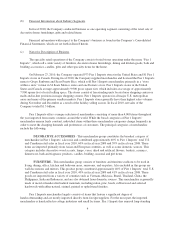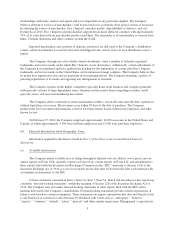Pier 1 2010 Annual Report Download - page 19
Download and view the complete annual report
Please find page 19 of the 2010 Pier 1 annual report below. You can navigate through the pages in the report by either clicking on the pages listed below, or by using the keyword search tool below to find specific information within the annual report.
In recent years, dispute resolution processes have been utilized to resolve disputes regarding market
access between the European Union, China, the United States and other countries. In some instances, these trade
disputes can lead to threats by countries of sanctions against each other, which can include import prohibitions
and increased duty rates on imported items. The Company considers any agreement that reduces tariff and
non-tariff barriers in international trade to be beneficial to its business. Any type of sanction on imports is likely
to increase the Company’s import costs or limit the availability of merchandise purchased from sanctioned
countries. In that case, the Company may be required to seek similar merchandise from other countries.
Risks Relating to Liquidity
A disruption in the global credit and equity markets could adversely impact the Company’s ability to
obtain financing on acceptable terms.
In the future, the Company could become dependent on the availability of adequate capital to fund its
operations. Disruption in the global credit and equity markets and future disruptions in the financial markets
could adversely affect the Company’s ability to enter into new financing agreements or obtain funding through
the issuance of Company securities. A decline in economic conditions could also result in difficulties for
financial institutions and other parties that the Company does business with, which could potentially affect the
Company’s ability to access financing under existing arrangements or to otherwise recover amounts as they
become due under the Company’s contractual agreements. The inability of the Company to obtain financing as
needed, on acceptable terms in order to fund its operations may have a material adverse impact on the
Company’s business, financial condition and results of operations.
Insufficient cash flows from operations could result in the substantial utilization of the Company’s
secured credit facility, which may impose certain financial covenants.
The Company maintains a secured credit facility to enable it to issue merchandise and special purpose
standby letters of credit as well as to fund working capital requirements. Borrowings under the credit facility are
subject to a borrowing base calculation consisting of a percentage of certain eligible assets of the Company and is
subject to advance rates and commercially reasonable reserves. Substantial utilization of the availability under
the borrowing base will result in various restrictions on the Company including: restricted ability of the Company
to repurchase its common stock or pay dividends, dominion over the Company’s cash accounts, and compliance
with a minimum fixed charge coverage ratio. As of the end of fiscal 2010, the Company’s minimum fixed charge
coverage ratio, if calculated, would have exceeded this required minimum under the agreement. See Note 5 to the
Notes to Consolidated Financial Statements for additional discussion regarding the Company’s secured credit
facility. Significant decreases in cash flow from operations and investing could result in the Company’s
borrowing increased amounts under the credit facility to fund operational needs. Increases in utilization of letters
of credit and/or increased cash borrowings could result in the Company being subject to these limitations.
Item 1B. Unresolved Staff Comments.
None.
Item 2. Properties.
The Company is headquartered in Fort Worth, Texas. In August 2004, the Company completed
construction of a corporate headquarters facility, which contains approximately 460,000 square feet of office
space. On June 9, 2008, the Company sold its headquarters building and accompanying land. As part of the
transaction, the Company entered into a lease agreement to rent approximately 250,000 square feet of office
space in the building for a primary term of seven years beginning on the closing date, with one three-year
renewal option, and a right to terminate the lease at the end of the fifth lease year.
13
























